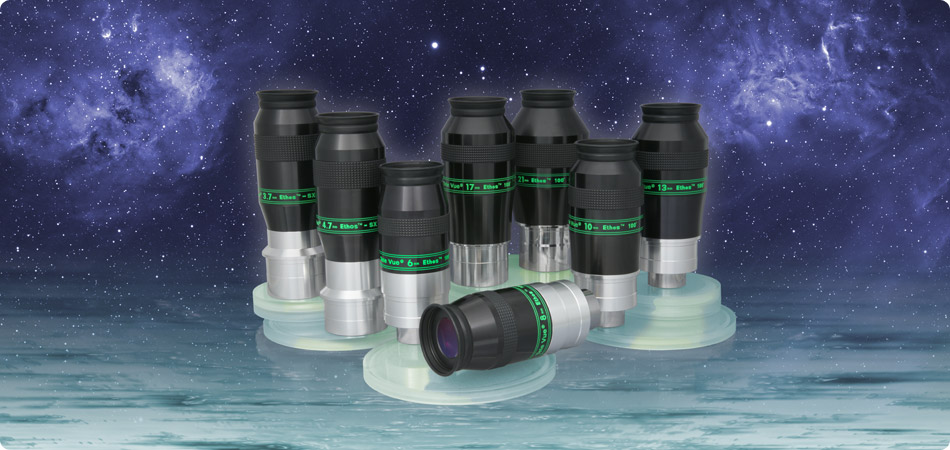
Tele Vue is known for its in-house eyepiece and telescope designs by Al Nagler; our latest eyepieces brings new meaning to the term "in-house." The concept for this eyepiece series was proposed by Tele Vue President David Nagler, with performance parameters giving it the fundamental characteristics (the ethos) of a Tele Vue eyepiece: high contrast, comfortable eye relief and full field sharpness. Control of astigmatism, field curvature, lateral color, angular magnification distortion correction, and low pupil sensitivity for daytime use were specified criteria.
Following Tele Vue's philosophy of pushing the state of the art, long-time Tele Vue employee and optical design protégé Paul Dellechiaie took up the challenge and designed the basic eyepiece form. Under Al's guidance, Paul tweaked his design to fulfill the original goals.
While sharpness is inherent to the optical design, contrast is maximized through the intelligent use of flat finished baffles and ultra low reflectance, high efficiency coatings tuned to the composition of each element.
Introduced at the 2007 Northeast Astronomy Forum, Tele Vue once again broadened the amateur astronomer's perspective on the universe with: 100° of pure Tele Vue quality. The field area of this new eyepiece is more than 50% larger than an 82° field. The Tele Vue Ethos is essentially multiple eyepieces, delivering the true field size of a longer focal length, narrower apparent field eyepiece with the benefits of higher power and darker sky background.
We invited NEAF attendees to take a look and see the universe the way we think it was meant to be experienced, with a field of view incredibly wide and sharp! We were very pleased indeed by the response and validation of our design goals.
With 110°, the Ethos-SX has 21% more AFOV area than the 100° Ethos design. This permits a nice 62% power increase from a 6mm Ethos, while retaining 68% of its TFOV. The 3.7mm actually has more TFOV than our 8mm Plössl, 6mm Radian, and 5mm Nagler Type-6!
In 1¼" mode, it is parfocal with the wide range of 1¼" Tele Vue Plössls, Panoptics, Radians, Naglers, Nagler Zooms, and 6mm and 8mm Ethos eyepieces. The screw-on 2" adapter (included) is designed to make it parfocal with 13mm and 10mm Ethos when they are used in their 2" modes.
Al Nagler eagerly pushed Ethos designer Paul Dellechiaie to extend the new 3.7mm focal length to reach 110°, the same field size as the LEM Simulator optics Al designed 45-years ago to train NASA astronauts for lunar landings.
The new 4.7mm Ethos-SX, like its 3.7mm progenitor, is designed and crafted to combine its exceedingly wide field of view with all the contrast, color-rendition, distortion correction and center-to-edge sharpness needed to achieve that natural view.
Compared to a lower power eyepiece with the equivalent TFOV (similar field stop) such as an 11mm Plössl (9.1mm field stop), the greater power - for higher resolution, and smaller exit pupil (for a darker background to enhance contrast) reveals a deep sky experience "even better than you imagined".
The 4.7mm is a 1¼" format and is parfocal with the wide range of 1¼" Tele Vue eyepieces. 2" adapter included.
In 1¼" mode, if you use Tele Vue's "high-hat" 2"-1¼" adapter, it will be parfocal with Tele Vue's Plössls, Radians, Type 6 Naglers, Nagler Zooms, 1¼" Panoptics and 8mm ETHOS.
The 10mm is parfocal with the 13mm ETHOS.
Its 59mm rubber grip diameter makes this model usable in binocular viewers — for most people.
We have not specifically endorsed the 13mm Ethos for Bino-Vue use because of the large diameter barrel. Even so, we were advised by Mike Harvey at the Winter Star Party (February 2008) that only 1-person in 25 had interpupilary limits with the bino'd Ethos (63.5-mm for the initial production 13mm).
However, since many of our customers have been thrilled with the experience, we have maximized the potential use by narrowing the barrel from 63.5-mm to 62-mm diameter for eyepieces delivered beginning mid-March 2008. While the difference is only 1.5-mm, (or 0.75-mm for pairing a first production unit with current production) we decided to make this small change public, in case you want to give it a try.
The 17mm ETHOS is an ideal complement to the 31mm Nagler Type-5. They are parfocal (both have focus locations about 3/8" above shoulder) and the 31mm Nagler Type-5 has exactly twice the true field area.
The 21mm focal length completes the logical set of 21mm/13mm/8mm and nicely juxtaposes the 17mm/10mm/6mm combination. Each step within these two sets approaches a 3x field area gain. The 21mm's effective field stop diameter is 36.2mm, bringing its true field close to the 35mm Panoptic (38.7mm Field Stop diameter). Its true field is also larger than the 26mm Nagler with its 35mm effective field stop diameter. In an f/4 Dobsonian, the exit pupil is just 5.25mm using the 21mm Ethos instead of 8.75mm with a 35mm Panoptic, or 6.5mm with a 26mm Nagler.



























 Fast & Reliable Delivery
Fast & Reliable Delivery Helpful & Friendly Staff
Helpful & Friendly Staff Best Prices Online
Best Prices Online 100% Secure Shopping
100% Secure Shopping